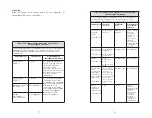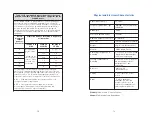
10
9
11
12
Table 201: Guidance and manufacturer's declaration –
electromagnetic emissions
The VeriChip H2 Reader is intended for use in the electromagnetic
environment specified below. The customer or the user of the
VeriChip H2 Reader should assure that it is used in such an
environment.
Emissions test
Compliance
Electromagnetic
environment guidance
RF emissions
CISPR 11
Group 1
The VeriChip H2 Reader
uses RF energy only for
its internal function.
Therefore, its RF
emissions are very low
and are not likely to cause
any interference in the
nearby electronic
equipment.
RF emissions
CISPR 11
Class B
The VeriChip H2 Reader
is suitable for use in all
establishments, including
domestic establishments
and those directly
connected to the public
low-voltage power supply
network that supplies
buildings used for
domestic purposes.
Harmonic emissions
IEC 61000-3-2
Not applicable
Voltage
Fluctuations/
flicker emission
Not applicable
Table 202: Guidance and manufacturer's declaration-
electromagnetic immunity
The VeriChip H2 Reader is intended for use in the electromagnetic
environment specified below. The customer or the user of the
VeriChip H2 Reader should assure that it is used in such an environment.
Immunity test IEC 60601
test level
Compliance
level
Electromagnetic
environment
guidance
Electrostatic
discharge
(ESD)
IEC 61000-4-2
±6 KV contact
±8 KV air
±6KV contact
±8 KV air
Floors should
be wood,
concrete or
ceramic tile. If
floors are
covered with
synthetic
material, the
relative humidity
should be at
least 30%.
Electrical fast
transient/burst
IEC 61000-4-4
±2 KV for power
supply lines
±1 KV for input/
output lines
Not applicable
Not applicable
Surge
IEC 61000-4-5
±1 KV
differential
mode
±2 KV common
mode
Not applicable
Not applicable
Voltage dips,
short
interruptions
and voltage
variations on
power supply
input lines
IEC 61000-4-11
<5 %
U
T
(>95%
dip in
U
T
) for 0.5
cycle 40%
U
T
(60 % dip in
U
T
)
for 5 cycles 70%
U
T
(3 % dip in
U
T
)
for 25 cycles
<5%
U
T
(>95 %
dip in
U
T
) for 5
sec
Not applicable
Not applicable
Power
Frequency
(50/60 Hz)
magnetic field
IEC 61000-4-8
3 A/m
3 A/m
Power
frequency
magnetic fields
should be at
levels
characteristic
of a typical
location in
a typical
commercial
or hospital
environment.
host computer side. For example, a communication program
(HyperTerminal or “keyboard wedge”) may be open and left
running regardless of the VH2R being powered on or off. The
VH2R stores the host’s BT MAC address in its non-volatile
memory, and will dial only this address no matter how many
devices it discovers performing the inquiry. The MAC address
should be entered into the device by using other communication
modes (such as USB or BT Slave) that does not require
a priori
knowledge of this address. When Bluetooth encryption is
desired, it must be enabled on both sides of the link (an identical
passkey word supplied). In this case the passkey should be
entered on the PC side only once, during the ‘pairing’ process. All
subsequent connections between the members of the same pair
will be encrypted automatically, and establishing subsequent
links will not require entering the passkey unless the devices
become ‘unpaired’.
The operation is performed as follows:
To operate in this mode the user should perform the following actions:
• Bring the VH2R and host system within Bluetooth range
(about 10m under most conditions).
• Start the communication program on the host side
(HyperTerminal or keyboard wedge). The exact number of
the serial port to be used for this connection should be
provided by the Bluetooth service. It has been noticed that
although Windows XP has some built-in Bluetooth support
that can be used to establish the connection, it is
significantly slower than a proprietary stack that comes
with particular BT hardware (e.g. BlueSoleil).
• Power up the VH2R by pressing the F1 button and enter the
authorization code if prompted. The device will try to discover
and dial the host. If this is the first time connection, the user
must enter the passkey on the PC side to allow the VH2R
connection to the PC. If this process has been successful, the
user will be prompted to press the F1 button once again to
initiate scanning for a Microtransponder. If the user presses
the F1 button without waiting for connection, the VH2R will
abort the attempt and go into standalone mode. If the unit
cannot discover the host within 20 seconds, it will
automatically abandon the attempt and proceed in
standalone mode.
• The VH2R will turn on the low frequency (LF) interrogation field
and try to acquire a Microtransponder. The field will stay on for
12 seconds or until a valid Microtransponder is acquired. If a
Microtransponder has not been acquired, the VH2R will go into
idle mode producing a corresponding message on the LCD. If a
Microtransponder has been acquired, its ID number will be
displayed on VH2R LCD and sent to the host via the BT
interface (if the connection had been established). After this
the VH2R will enter its idle mode and be ready for another scan
or power down after 5 minutes. To shut the unit down earlier,
the user can press the F2 and F3 buttons simultaneously.
VeriChip H2 Reader Configuration Options
USB Override.
As described above, the normal way of changing the connection
mode is through the established USB (serial) connection.
However, to recover from a situation when the Bluetooth-
enabled host becomes unavailable for some reason (for
example: The unit had been configured to work as Bluetooth
master and programmed with a particular slave MAC address,
but that host device is not available), an emergency override
procedure exists.
To activate the override, the user should power up the VH2R
while holding down the Left auxiliary button (F2) until the unit
enters the self-test mode. The unit will switch into the USB
connection mode regardless of what had been stored in the
EEPROM, and thus enable the user to connect the Reader to the
host by means of USB cable and perform necessary changes.
This override is not memorized in the EEPROM and so is valid
for this session only, until the unit is powered down. This
procedure can also be used for temporary work in USB mode if
the normal Bluetooth-enabled host is unavailable (a different
work location, etc.) without the need to re-configure the device.
Cleaning
Wipe the Reader with alcohol wipes. Do not submerge or
spray liquid directly on the Reader.











